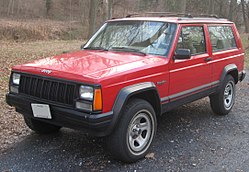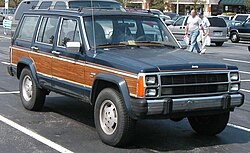From Wikipedia, the free encyclopedia
- See also Jeep Cherokee for other models using this name
 | |
| Manufacturer | American Motors (AMC) Chrysler Corporation DaimlerChrysler |
|---|---|
| Production | 1984–2001 (USA) 1984–2005 (China) |
| Assembly | Toledo, Ohio Beijing, China |
| Successor | Jeep Liberty |
| Class | Compact SUV |
| Body style(s) | 2-door SUV 4-door SUV |
| Layout | Front-engine, rear-wheel drive / Four-wheel drive |
| Engine(s) | 2.5 L AMC 150 I4 2.8 L GM 60° LR2 V6 2.1 L Renault diesel I4 4.0 L AMC 242 I6 4.0 L AMC 242 H.O. I6 4.0 L 242 Power Tech I6 2.5 L VM Motori diesel I4 |
| Transmission(s) | 4-speed Aisin AX-4 manual 4-speed Borg-Warner T-4 manual 5-speed Aisin AX-5 manual 5-speed Aisin AX-15 manual 5-speed Borg-Warner T-5 manual 5-speed NVG NV3550 manual 5-speed Peugeot BA-10/5 manual 3-speed Chrysler A904 automatic 3-speed 30RH automatic 4-speed Aisin AW-4 automatic |
| Wheelbase | 101.4 in (2576 mm) |
| Length | 1987-1990: 165.3 in (4199 mm) 1991-93: 168.8 in (4288 mm) 1994-96: 166.9 in (4239 mm) 1997-2001: 167.5 in (4255 mm) |
| Width | 1987-1993: 70.5 in (1791 mm) 1994-96: 67.7 in (1720 mm) 1997-99: 67.9 in (1725 mm) 2000-01: 69.4 in (1763 mm) |
| Height | 1987-88 2WD: 63.4 in (1610 mm) 1987-1993: 63.3 in (1608 mm) 1994-99 2WD: 63.9 in (1623 mm) 1994-2001 4WD: 64.0 in (1626 mm) 2000-01 2WD: 63.8 in (1621 mm) |
| Curb weight | 3057 lb (1387 kg) (approx.) |
The Jeep Cherokee (XJ) was a monocoque (unibody) compact SUV. It shared the name of the original full-size SJ model, but having no true pickup truck heritage, it actually set the stage for the modern SUV. Its innovative appearance and sales popularity spawned important imitators as other automakers began to notice that this model began replacing regular cars.[1] It was built in Toledo, Ohio in the United States and in Beijing, China. The XJ platform provided the mechanical basis for the MJ-series Jeep Comanche pick-up.
The XJ was selected by Robert Cumerford as one of the 20 greatest cars of all time, calling it "possibly the best SUV shape of all time, it is the paradigmatic model to which other designers have since aspired."[2]
1984-1996
The XJ Cherokee was introduced in 1984 as the first unibody Jeep. Designs of the XJ Cherokee date back to 1978 when a team of American Motors (AMC) and Renault engineers drew several sketches. A few clay models were based on the existing SJ Cherokee. Early sketches of the XJ Cherokee had an European influence, and most of the styling cues were done by AMC engineers. The ongoing debate suggests that Renault sketch artists were involved right after the 1979 partnership with AMC.[citation needed] Noticing that General Motors was developing a new two-door S-10 based Blazer, AMC decided to design an entirely new four-door model, but worried about rollovers Gerald C. Meyers hired one of Ford's best engineers, Roy Lunn to design what is known as the Quadra-Link suspension.[3] François Castaing developed the drivetrain using a much smaller engine than normally found in 4WD vehicles and reduced the weight of the new model,[4]
Both two- and four-door versions of the XJ Cherokee were offered throughout its lifetime, each having exactly the same track and wheelbase measurements. Two-door models, however, received longer doors and front seats that could fold forward to assist in rear passenger entry and exit. This was in addition to extended-length rear windows that did not open, although an optional rear vent window was available on some models. Its appearance has led some to mistakenly believe that the two-door models are a short wheelbase version of the four-door.
A variation on the Cherokee from 1984 through 1990 was the Jeep Wagoneer. It was sold in two trim levels: the Wagoneer and the Wagoneer Limited. Both Wagoneers were distinguished from the Cherokee by the four headlights. The Wagoneer Limited came with vinyl wood trim on the sides.
This version was the first to be sold in Europe; it was launched in 1992 in some markets, 1993 for the United Kingdom. Early versions had the 4.0 L (242 CID) six-cylinder engine only: the 2.5 L (150 CID) engine did not arrive in Europe until 1995.
American Motors's compact XJ Cherokee was to be replaced by a new and larger model known as the XJC (later named the Jeep Grand Cherokee when introduced in 1993) that was under development by AMC.[5] However, the smaller model's continuing popularity caused Chrysler executives, as the new owners of AMC, to rethink this decision. The Jeep XJ has remained a popular choice by off-roading enthusiasts due to its potent off-roading capability in stock form. Its popularity has resulted in strong ongoing aftermarket support in the form of a wide variety of products and upgrade availability.
1997-2001
After 13 years of production, 1997 saw the Cherokee receive updated exterior and interior styling. Both the two- and four-door bodies remained in production, receiving a steel tailgate (replacing the fiberglass one used previously),a new taillight design, additional plastic molding along the doors, as well as a new front header panel that featured more aerodynamic styling; the interior was similarly updated with an all-new design and instruments, and a stiffer unibody frame brought improvements to Noise, Vibration, and Harshness measurements. Both the 4- and 6-cylinder engines were offered through the 2000 model year, though only the straight-six was available in 2001. For the 2000 and 2001 model years, all six-cylinder XJs received a distributorless ignition system using coil-on-plug ignition replacing the 'traditional' system previously used; coupled with better exhaust and intake porting, this gave a minor increase in power over the previous models. Transmission, axle, and transfer case choices were carried over from the previous models.
The Jeep Liberty (KJ) was already a done deal to replace the Cherokee, but in a quote from Brandweek: one of the first moves Wolfgang Bernhard made when he came to Chrysler in 2000 was to help kill the XJ Cherokee.[6] Thus, the (XJ) Cherokee line was replaced in 2002 by the Jeep Liberty (KJ), although it is called the "Cherokee" in most foreign markets. When (XJ) Cherokee production ended in mid 2001, the portion of the Toledo South Assembly Plant devoted to its production was slowly torn down.




